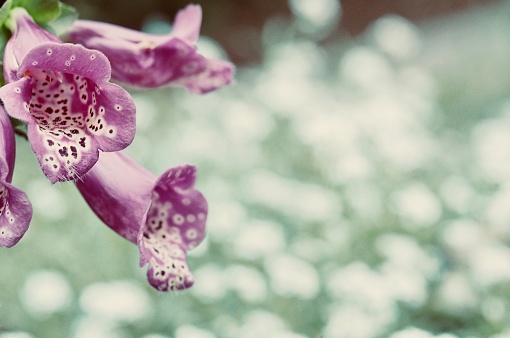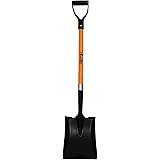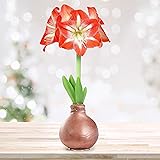Like most people, you may have foxgloves in your garden. Foxgloves are beautiful plants with clusters of trumpet-shaped flowers in various colors, a sight to see in many gardens across the United States. But are you puzzled about what to do with Foxgloves in the fall?
You should remove the spent flowers, lightly fertilize the foxgloves and moisturize the soil around them. However, you should spare some flowers if the plant has lived for two years and is dying already.
Even if the weather’s starting to turn a little chilly, you can still do plenty of things to make your garden look great. I’ll talk about what to do with foxgloves in the fall in this post. Keep reading for some tips!
Also check: Should Foxgloves Be Cut BAck?
What to Do With Foxgloves in the Fall?
You should remove the spent flowers by deadheading the spikes. However, save some of the seeds if the foxglove has lived for about two years. Additionally, you should moisturize its environment and fertilize it in preparation for the cold and dry winter.
Once your foxglove ‘enters’ the fall season, it is essential to care for the plant properly to encourage future blooming.
Here is what to do with foxgloves in the fall to ensure they blossom in the next season:
Remove Spent Flowers
Cut off or deadhead the flower spikes after the bloom season. Usually, foxgloves will shed the flowers and leaves during fall in preparation for dormancy. However, the growth of spikes continues as the plant prepares for self-seeding. But self-seeding may not do your garden any good!
Self-seeding seeds do not germinate or grow in any desirable pattern. Additionally, the seeds have a low survival rate. Therefore, they may end up not germinating at all!
Removing spent flowers prevents the plant from setting seeds. As a result, the plant redirects its energy into producing new flowers next season.
Leave Some Flowers
If you want your foxglove to self-seed, leave a few flower spikes on the plant. Once the flowers self-seed, cut off the entire spike.
In case you’re in the dark, self-seeding is when a plant drops its capsules. The process often happens at the end of the season, and if everything goes well, the seeds germinate and grow into new plants.
However, I don’t recommend self-seeding, mainly because it can destroy the pattern of your garden. It makes your flower farm a little bushy. Instead, harvest them and seed them in a more orderly way.
Leaving some flowers ensures the continuity of your foxglove flowers. You can harvest the seeds and germinate them into new young plants to revamp your garden’s look.
Fertilize
Foxgloves are heavy nutrient feeders and will benefit from a monthly fertilizer feeding during the growing season. Add a ‘small amount’ of fertilizer but don’t overdo it!
In fact, just adding a small layer of organic manure or decomposed mulching would do better. If the soil is richer, foxgloves can do without the fertilizer.
But just how much is a small amount? How much fertilizer should you add to your foxgloves?
Add 2 to 3 pounds of balanced fertilizer for every 100ft2 of the flower garden. It is advisable not to use a balanced fertilizer as it can be detrimental to the soil and the plant. Usually, balanced fertilizers have high levels of phosphorus. Instead, use a 10-20-10 or 5-10-5 fertilizer.
Water Regularly
Keep the soil evenly moist but not soggy. But why not soggy? Every plant loves water, right? Wrong!
Foxgloves are prone to crown lot and powdery mildew. The former occurs when foxglove plants lack enough water drainage, whereas the latter results from improper air circulation. Therefore, keep the soil moist.
The best method to water your foxgloves is using a drip hose. Avoid overhead watering by all means as it can bring about fungal diseases.
If you follow these simple tips to the letter, your foxgloves survive the fall season into winter. And without a doubt, they’ll continue to bloom for many seasons to come.
Should Foxglove Be Cut Back In The Fall?
Yes, you should cut perennial foxgloves back for autumn to prepare them for bloom the following year. However, you do not need to cut back biennial foxgloves in the fall but rather dig them up after seeding.
The difference between biennial and perennial foxgloves is that the former produces foliage in the first year, flowers in the second season, and then dies, while the latter flowers every year.
Both foxgloves species are beautiful, old-fashioned flowers that can add a touch of elegance to any garden. But if you’re not careful, they can also take over your entire yard!
That’s why it’s essential to know when and how to trim back your foxgloves.
When Should You Cut Back A Foxglove?
You should cut back a foxglove in fall; it’s the perfect time to give it a good trim.
By cutting them back now, you’ll help them stay healthy and prevent them from getting too big and unruly. Plus, it’s a great way to tidy up your garden before winter sets in.
Now that you understand why it’s essential and when the right time to trim them is, how do you prune?
How Do You Prune Foxgloves In The Fall?
You prune foxgloves in the fall by:
- Cutting the stem back to about a third or half above the ground and letting it dry off. Typically, the foxglove’s height is 3 to 8 feet.
- Cutting off any dead or dying leaves or flowers using a pair of sears. By doing so, you stimulate the growth of new parts after winter.
- Try to avoid cutting into the green–growing parts of the plant. When you cut green parts, the plants spend the much-reserved energy healing up the wounds.
- Don’t trim them back too severely – you don’t want to shock the roots. Shaking the roots just before winter could factor into their drying.
You should observe the few tips above when trimming back foxgloves in the fall. Otherwise, you will end up destroying their lifecycle!
How Do You Know That Foxglove Is Done Blooming for the Season?
You know that foxglove is done blooming for the season when it drops plant leaves, flowers, and self-seeds—additionally, its color changes in preparation for the cold and dry season.
But there is more! I’ll explain what happens when your foxglove completes blooming for the season and what it means. Here are the tips:
Plant Leaves
One way to tell that foxglove blooming season is over is by observing the plant’s leaves. It’s one of the most conspicuous signs. So what should you observe on the leaves?
Usually, the leaves start to turn yellow or brown, which indicates that the plant is no longer in bloom. Another clue is that when foxglove finishes blooming, the flowers begin to wilt and drop.
Foxgloves shed leaves to conserve energy for the cold and dry winter. Otherwise, they would spend a lot of energy protecting leaves from dying.
Once you observe that leaves are falling and flowers are wilting, it’s time to start thinking about what to do with your foxgloves in the fall.
Seeds
Seeds are another vital sign that you can never go wrong about. By looking at the seeds, you can tell that foxglove finished blooming for the season. So what is there to look at?
When foxglove is ready for winter, the seeds turn from green to black. This transition means that the seeds are ripening and almost ready for self-seeding.
If you want to save the seeds to plant next year, harvest them when they’re ripe and black. The harvesting process is relatively easy; cut the flower stalks, shake them to detach seeds, and collect the seeds for storage.
When The Foxglove Starts To Die
Usually, foxgloves die after two years, and when they do, their leaves and stems turn brown and dry up. Foxglove starts dying immediately when the blooming season is over.
That usually happens towards the end of the second year’s summer or early fall. It is the best time to harvest the seeds and save the plant.
It’s important to know when the foxglove blooming season is over so that you can take the appropriate action. Such actions include preparing the resources so that you can take care of the garden in the fall and harvesting seeds.
What to Avoid Doing to Foxgloves During Fall?
You should avoid pruning green leaves, moving the plant, or fertilizing it too much during the fall. Also, avoid soaking the foxgloves in water.
Generally, it’s essential to avoid doing anything that would stress the plant or disturb its roots. You probably want to know more, right? No hurry, I’ll expound on each of the points.
Let’s start.
Don’t Prune Green Foxglove Leaves
Though it may be tempting to tidy up your foxgloves by pruning away the green leaves, this can do more harm than good. Instead, let the leaves dry up first. But why shouldn’t you?
Pruning stimulates new growth as the foxglove tries to heal the scar (callus). And you don’t want to encourage growth during fall. Instead, the plant may die.
Don’t Move Foxgloves
Unlike some experts, I’m highly against moving the plants (any type) in the fall. If you need to transplant your foxgloves, do it in the spring when they’re not using much water.
Fall is when foxgloves are preparing to go dormant, so moving them can shock the plant and damage its roots. Besides, they are not actively growing.
Don’t Water Foxgloves Too Much
As aforementioned, regulate the amount of water you point on foxgloves during the fall. You should drip enough water to make the soil moist. Otherwise, overwatering can lead to root rot and kill the plant.
Additionally, too much water during fall is a hub for diseases. Some of the diseases I previously mentioned include crown rot and powdery mildew.
The above simple guidelines will ensure that your foxgloves stay healthy during fall and withstand the cold winter months.
Conclusion
So, now that you know how to properly take care of your foxgloves during the fall season, keenly avoid doing anything that might harm them. If you follow the above simple tips, your foxgloves will stay healthy, and you’ll be happy all fall long!





